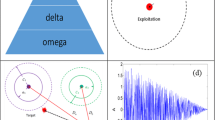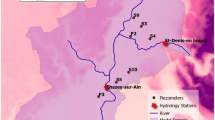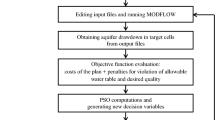Abstract
The simulation-optimization approach is often used to solve water resource management problem although repeated use of the simulation model enhances the computational load. In this study, Artificial Neural Network (ANN) and Bagged Decision Trees (BDT) models were developed as an approximator for Analytic Element Method (AEM) based groundwater flow model. Developed ANN and BDT models were coupled with Particle Swarm Optimization (PSO) model to solve the well-field management problem. The groundwater flow model was developed for the study area and used to generate the dataset for the training and testing of the ANN & BDT models. These coupled ANN-PSO & BDT-PSO models were employed to find the optimal design and cost of the new well-field system by optimizing discharge & co-ordinate of wells along with the cost effective layout of piping network. The Minimum Spanning Tree (MST) based model was used to find out the optimal piping network layout and checking the hydraulic constraints in the piping network. The results show that the ANN & BDT models are good approximators of AEM model and they can reduce the computational burden significantly although ANN model performs better than BDT model. The results show that the coupling of piping network model with simulation-optimization model is very significant for finding the cost effective and realistic design of the new well-field system.






Similar content being viewed by others
References
ASCE Task Committee (2000) Application of artificial neural networks in hydrology artificial neural networks in hydrology I: preliminary concept. J Hydrol Eng 5-2:115–123
Adams R, Parkin G (2002) Development of a coupled surface-groundwater-pipe network model for the sustainable management of karstic groundwater. Environ Geol 42:513–517
Arndt O, Barth T, Freisleben B, Grauer M (2005) Approximating a finite element model by neural network prediction for facility optimization in groundwater engineering. Eur J Oper Res 166:769–781
Atiya A, Ji C (1997) How initial conditions affect generalization performance in large networks. IEEE Trans on Neural Netw 8(2):448–451
Ayvaz MT (2016) A hybrid simulation–optimization approach for solving the areal groundwater pollution source identification problems. J Hydrol 538:161–176
Bieupoude P, Azoumah Y, Neveu P (2012) Optimization of drinking water distribution networks: computer-based methods and constructal design. Comput Environ Urban Syst 36:434–444
Breiman L (1994) Bagging predictors. Technical Report 421, Department of Statistics, University of California at Berkeley
Coppola E, Poulton M, Charles E, Dustman J (2003) Application of artificial neural networks to complex groundwater management problems. Int Assoc Math Geol 12(4):303–320
Christelis V, Mantoglou A (2016) Pumping optimization of coastal aquifers assisted by adaptive metamodelling methods and radial basis functions. Water Resour Manag 30:5845–5859
Emch PG, Yeh WG (1998) Management model for conjunctive use of coastal surface water and groundwater. J Water Resour Plan Manag 124:129–139
Finney BA, Samsuhadi WR (1992) Quasi-three-dimensional optimization model for Jakarta basin. J Water Resour Plan Manag 118:18–31
Gaur S, Chahar BR, Graillot D (2011) Analytic elements method and particle swarm optimization based simulation-optimization model for groundwater management. J Hydrol 402(3–4):217–227
Karatzas GP (2017) Developments on modeling of groundwater flow and contaminant transport. Water Resour Manag 31(10):3235–3244
Johnson VM, Rogers LL (1995) Location analysis in ground-water remediation using neural networks. Ground Water 33(5):749–758
Lefkoff LJ, Gorelick SM (1986) Design and cost analysis of rapid aquifer restoration systems using flow simulation and quadratic programming. Ground Water 24:777–790
Math Works Inc (2001) MATLAB V R2009a, Apple Hill drive, Natick, Massachusetts, USA
Morshed J, Kaluarachchi JJ (1998) Application of artificial neural network and genetic algorithm in flow and transport simulations. Adv Water Resour 22(2):145–158
Moradi JM, Marino MA, Afshar A (2003) Optimal design and operation of irrigation pumping station. J Irrig Drain Eng 129(3):149–154
Nikolos IK, Stergiadi M, Papadopoulou MP, Karatzas GP (2008) Artificial neural networks as an alternative approach to groundwater numerical modelling and environmental design. Hydrol Process 22:3337–3348
Nicklow J (2010) State of the art for genetic algorithms and beyond in water resources planning and management. J Water Resour Plann Manag 136:412–432
Rogers LL, Dowla FU (1992) Groundwater remediation optimization with artificial neural networks and the genetic algorithm. Eos Trans AGU Fall Meeting 73:186
Sharma AK, Swamee PK (2006) Cost considerations and general principles in the optimal Design of Water Distribution Systems. ASCE Conference Proceeding 247:85
Singh RM, Datta B, Jain A (2004) Identification of unknown groundwater pollution sources using artificial neural networks. J Water Resour Plan Manag 130(6):506–514
Somaida MM, El-ZaharMedhat MH, Yasser AH, Mahmoud SS (2013) Optimizing pumping rate in pipe networks supplied by groundwater sources. KSCE J Civ Eng 17(5):1179–1187
Swamee PK (1996) Design of multistage pumping mains. J Transp Eng 122(1):1–4
Strack ODL (1989) Groundwater mechanics. Prentice-Hall, Englewood Cliffs, NJ
Swamee PK, Sharma AK (1990) Decomposition of large water distribution systems. J Environ Eng 116(2):269–283
Tsai FTC, Katiyar V, Toy D, Goff RA (2009) Conjunctive Management of Large-Scale Pressurized Water Distribution and Groundwater Systems in semi-arid area with parallel genetic algorithm. Water Res Manage 23:1497–1517
Wu ZY, Simpson A (2002) A self-adaptive boundary search genetic algorithm and its application to water distribution systems. J Hydraul Res 2:191–203
Zheng C, Wang PP (2002) A field demonstration of the simulation optimization approach for remediation system design. Ground Water 40(3):258–266
Acknowledgements
A previous shorter version of the paper was presented in the 10th world congress of EWRA “Panta Rei” Athens, Greece, 5-9 July 2017.
Author information
Authors and Affiliations
Corresponding author
Ethics declarations
Conflict of Interest
The authors declare that they have no conflict of interest.
Rights and permissions
About this article
Cite this article
Gaur, S., Dave, A., Gupta, A. et al. Application of Artificial Neural Networks for Identifying Optimal Groundwater Pumping and Piping Network Layout. Water Resour Manage 32, 5067–5079 (2018). https://doi.org/10.1007/s11269-018-2128-9
Received:
Accepted:
Published:
Issue Date:
DOI: https://doi.org/10.1007/s11269-018-2128-9




